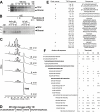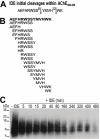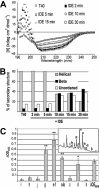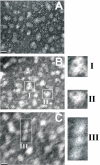Heterologous amyloid seeding: revisiting the role of acetylcholinesterase in Alzheimer's disease
- PMID: 17653279
- PMCID: PMC1920558
- DOI: 10.1371/journal.pone.0000652
Heterologous amyloid seeding: revisiting the role of acetylcholinesterase in Alzheimer's disease
Abstract
Neurodegenerative diseases associated with abnormal protein folding and ordered aggregation require an initial trigger which may be infectious, inherited, post-inflammatory or idiopathic. Proteolytic cleavage to generate vulnerable precursors, such as amyloid-beta peptide (Abeta) production via beta and gamma secretases in Alzheimer's Disease (AD), is one such trigger, but the proteolytic removal of these fragments is also aetiologically important. The levels of Abeta in the central nervous system are regulated by several catabolic proteases, including insulysin (IDE) and neprilysin (NEP). The known association of human acetylcholinesterase (hAChE) with pathological aggregates in AD together with its ability to increase Abeta fibrilization prompted us to search for proteolytic triggers that could enhance this process. The hAChE C-terminal domain (T40, AChE(575-614)) is an exposed amphiphilic alpha-helix involved in enzyme oligomerisation, but it also contains a conformational switch region (CSR) with high propensity for conversion to non-native (hidden) beta-strand, a property associated with amyloidogenicity. A synthetic peptide (AChE(586-599)) encompassing the CSR region shares homology with Abeta and forms beta-sheet amyloid fibrils. We investigated the influence of IDE and NEP proteolysis on the formation and degradation of relevant hAChE beta-sheet species. By combining reverse-phase HPLC and mass spectrometry, we established that the enzyme digestion profiles on T40 versus AChE(586-599), or versus Abeta, differed. Moreover, IDE digestion of T40 triggered the conformational switch from alpha- to beta-structures, resulting in surfactant CSR species that self-assembled into amyloid fibril precursors (oligomers). Crucially, these CSR species significantly increased Abeta fibril formation both by seeding the energetically unfavorable formation of amyloid nuclei and by enhancing the rate of amyloid elongation. Hence, these results may offer an explanation for observations that implicate hAChE in the extent of Abeta deposition in the brain. Furthermore, this process of heterologous amyloid seeding by a proteolytic fragment from another protein may represent a previously underestimated pathological trigger, implying that the abundance of the major amyloidogenic species (Abeta in AD, for example) may not be the only important factor in neurodegeneration.
Conflict of interest statement
Figures







Similar articles
-
In vivo localization of human acetylcholinesterase-derived species in a β-sheet conformation at the core of senile plaques in Alzheimer's disease.J Biol Chem. 2019 Apr 19;294(16):6253-6272. doi: 10.1074/jbc.RA118.006230. Epub 2019 Feb 20. J Biol Chem. 2019. PMID: 30787102 Free PMC article.
-
Green Tea Seed Isolated Theasaponin E1 Ameliorates AD Promoting Neurotoxic Pathogenesis by Attenuating Aβ Peptide Levels in SweAPP N2a Cells.Molecules. 2020 May 16;25(10):2334. doi: 10.3390/molecules25102334. Molecules. 2020. PMID: 32429462 Free PMC article.
-
Aggregation and catabolism of disease-associated intra-Abeta mutations: reduced proteolysis of AbetaA21G by neprilysin.Neurobiol Dis. 2008 Sep;31(3):442-50. doi: 10.1016/j.nbd.2008.06.001. Epub 2008 Jun 17. Neurobiol Dis. 2008. PMID: 18602473 Free PMC article.
-
Alzheimer's disease.Subcell Biochem. 2012;65:329-52. doi: 10.1007/978-94-007-5416-4_14. Subcell Biochem. 2012. PMID: 23225010 Review.
-
Impact of Insulin Degrading Enzyme and Neprilysin in Alzheimer's Disease Biology: Characterization of Putative Cognates for Therapeutic Applications.J Alzheimers Dis. 2015;48(4):891-917. doi: 10.3233/JAD-150379. J Alzheimers Dis. 2015. PMID: 26444774 Review.
Cited by
-
Infectivity versus Seeding in Neurodegenerative Diseases Sharing a Prion-Like Mechanism.Int J Cell Biol. 2013;2013:583498. doi: 10.1155/2013/583498. Epub 2013 Sep 25. Int J Cell Biol. 2013. PMID: 24187553 Free PMC article. Review.
-
Serine protease HtrA1 accumulates in corneal transforming growth factor beta induced protein (TGFBIp) amyloid deposits.Mol Vis. 2013 Apr 12;19:861-76. Print 2013. Mol Vis. 2013. PMID: 23592924 Free PMC article.
-
A novel process driving Alzheimer's disease validated in a mouse model: Therapeutic potential.Alzheimers Dement (N Y). 2022 Apr 5;8(1):e12274. doi: 10.1002/trc2.12274. eCollection 2022. Alzheimers Dement (N Y). 2022. PMID: 35415206 Free PMC article.
-
Can Activation of Acetylcholinesterase by β-Amyloid Peptide Decrease the Effectiveness of Cholinesterase Inhibitors?Int J Mol Sci. 2023 Nov 16;24(22):16395. doi: 10.3390/ijms242216395. Int J Mol Sci. 2023. PMID: 38003588 Free PMC article.
-
Advances in the pathogenesis of Alzheimer's disease: a re-evaluation of amyloid cascade hypothesis.Transl Neurodegener. 2012 Sep 21;1(1):18. doi: 10.1186/2047-9158-1-18. Transl Neurodegener. 2012. PMID: 23210692 Free PMC article.
References
-
- Haass C, Selkoe DJ. Soluble protein oligomers in neurodegeneration: lessons from the Alzheimer's amyloid β-peptide. Nat Rev Mol Cell Biol. 2007;8:101–112. - PubMed
-
- Selkoe DJ. Cell biology of protein misfolding: the examples of Alzheimer's and Parkinson's diseases. Nat Cell Biol. 2004;6:1054–1061. - PubMed
-
- Iwata N, Tsubuki S, Takaki Y, Shirotani K, Lu B, et al. Metabolic regulation of brain Aβ by neprilysin. Science. 2001;292:1550–1552. - PubMed
-
- Kurochkin IV. Insulin-degrading enzyme: embarking on amyloid destruction. Trends Biochem Sci. 2001;26:421–425. - PubMed
Publication types
MeSH terms
Substances
Grants and funding
LinkOut - more resources
Full Text Sources
Other Literature Sources
Medical

